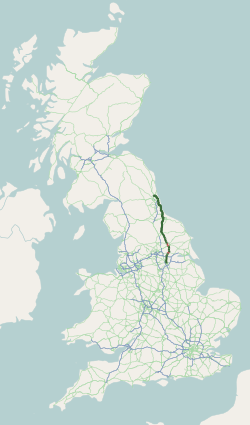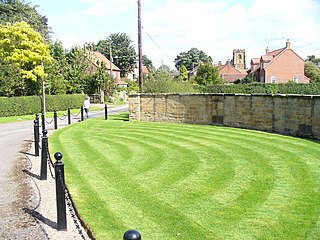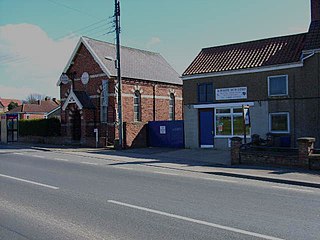
North Yorkshire is a ceremonial county in the Yorkshire and the Humber and North East regions of England. It borders County Durham to the north, the North Sea to the east, the East Riding of Yorkshire to the south-east, South Yorkshire to the south, West Yorkshire to the south-west, and Cumbria and Lancashire to the west.

Northallerton is a market town and civil parish in North Yorkshire, England. It is near the River Wiske in the Vale of Mowbray and had a population of 16,832 in 2011. Northallerton is an administrative centre for York and North Yorkshire Combined Authority and North Yorkshire Council.

Hambleton was a local government district in North Yorkshire, England. The administrative centre was Northallerton, and the district included the outlying towns and villages of Bedale, Thirsk, Great Ayton, Stokesley, and Easingwold.

Thirsk is a market town and civil parish in North Yorkshire, England; it is known for its racecourse, quirky yarn bombing displays and depiction as local author James Herriot's fictional Darrowby.

The A19 is a major road in England running approximately parallel to and east of the A1 road. Although the two roads meet at the northern end of the A19, the two roads originally met at the southern end of the A19 in Doncaster, but the old route of the A1 was changed to the A638. From Sunderland northwards, the route was formerly the A108. In the past the route was known as the East of Snaith-York-Thirsk-Stockton-on-Tees-Sunderland Trunk Road. Most traffic joins the A19, heading for Teesside, from the A168 at Dishforth Interchange.
Thornton-le-Moor is a village and civil parish in the Hambleton District of North Yorkshire, England, situated equidistantly from the towns of Thirsk and Northallerton.

Ainderby Steeple is a village and civil parish in North Yorkshire, England. Ainderby Steeple is situated on the A684 approximately 2.6 miles (4.2 km) south-west of the county town of Northallerton, and to the immediate east of Morton-on-Swale.

Borrowby is a village and civil parish in North Yorkshire, England. It is situated halfway between Thirsk and Northallerton, about 25 miles (40 km) north of York, in the Vale of Mowbray, a low-lying agricultural landscape shaped by the last glaciation, that lies between two national parks, the North York Moors to the east and the Yorkshire Dales to the west.

Carlton Miniott, formerly Carlton Islebeck is a village and civil parish in the Hambleton district of North Yorkshire, England, on the A61 road to the immediate west of Thirsk, 25 miles (40 km) north of York. According to the 2001 census it had a population of 926, increasing to 990 at the 2011 census.

South Kilvington is a village and civil parish in North Yorkshire, England. It is situated just off the A19, about one mile north of Thirsk.

Kirby Wiske is an English village and civil parish in the Hambleton District of North Yorkshire. It lies beside the River Wiske, about 4 miles (6.4 km) north-west of Thirsk.

Newby Wiske is a village and civil parish in the Hambleton district of North Yorkshire, England. It is situated on the River Wiske, about five miles north-west of Thirsk.

Morton-on-Swale is a large village and civil parish in North Yorkshire, England. It lies on the A684 road about 4 miles (6.4 km) west of the county town of Northallerton. It is less than 1 mile (1.6 km) to the village of Ainderby Steeple. As the name suggests it lies on the River Swale.

Pickhill is a village in North Yorkshire, England, 6 miles (10 km) west of Thirsk. It is a part of the civil parish of Pickhill with Roxby.

The River Wiske is a tributary of the River Swale in Yorkshire, England. The Wiske gives its name to several villages it passes through. The name Wiske is derived from an Old English word wisca meaning a water meadow. It was once known as the Foulbroke, a name for which some writers commented that it was well deserved.

Kirby Sigston is a denucleated village and civil parish in North Yorkshire, England, approximately 4 miles (6.4 km) east of Northallerton. The parish is situated on the Cod Beck river, and also includes the hamlet of Jeater Houses, east of the village on the A19 road, on the boundary with Thimbleby.

The A168 is a major road in North Yorkshire, England. It runs from Northallerton to Wetherby, acting as a local access road for the A1(M).

South Otterington is a village and civil parish in the Hambleton district of North Yorkshire, England. It is located on the A167 road 5 miles (8 km) south of Northallerton and on the east bank of the River Wiske.

The A684 is an A road that runs through Cumbria and North Yorkshire, starting at Kendal, Cumbria and ending at Ellerbeck and the A19 road in North Yorkshire. It crosses the full width of the Yorkshire Dales, passing through Garsdale and the full length of Wensleydale.



















